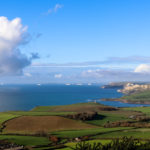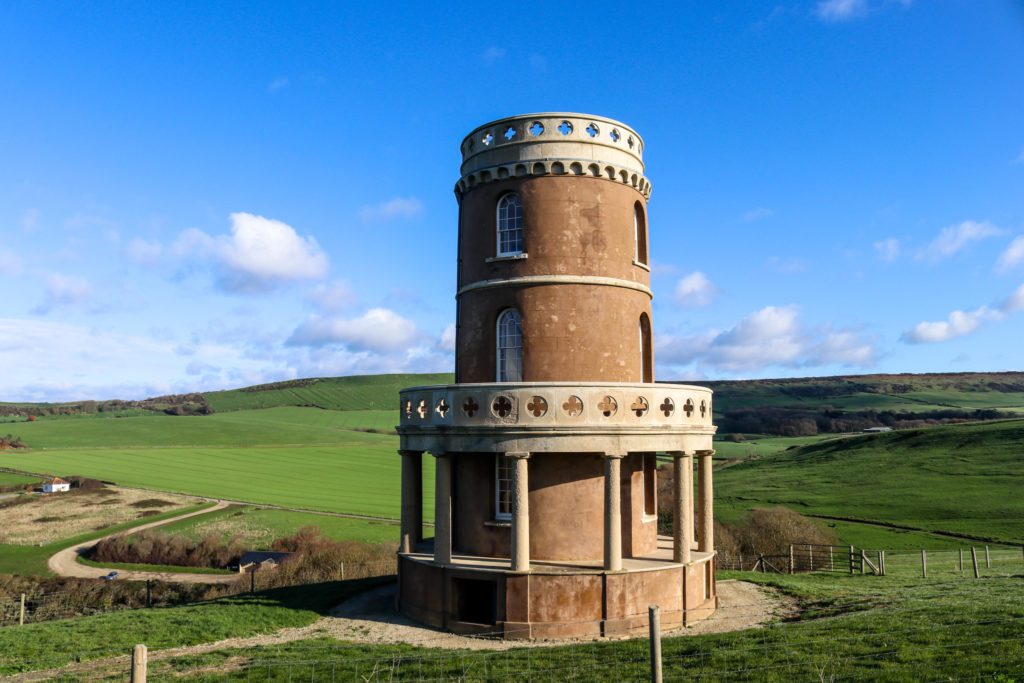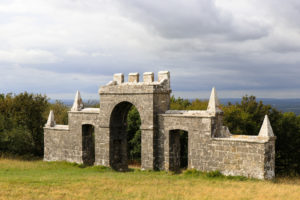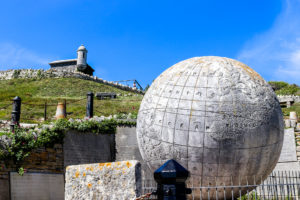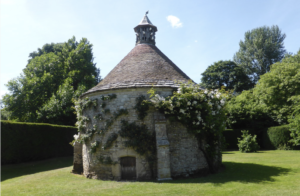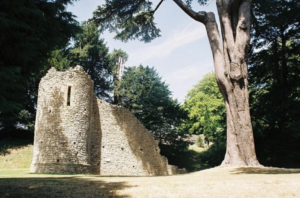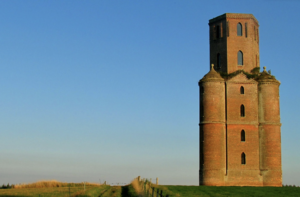This circular, Grade II, Tuscan-style tower overlooking Kimmeridge Bay is one of the most dramatic locations to be found on the Jurassic Coast.
You can walk up to view Clavell Tower from Kimmeridge village or via the South West Coast path – and you can even stay in it for a truly unique visit to Purbeck.
Built in 1830, Clavell Tower was initially used as a folly and observatory. Its unique position and captivating design has drawn visitors for generations and has been an inspiration to authors such as Thomas Hardy and PD James.
There may be opportunities to explore inside the tower on special open days. Find out when the next one is on the Landmark Trust’s website: www.landmarktrust.org.uk/
History of the tower

Clavell Tower sits above the 1,800 acre Smedmore Estate, which comprises much of Kimmeridge village and the beautiful, Grade II-listed manor Smedmore House, and has been in the same family since the 1400s.
In 1830, the then owner of Smedmore House – the Reverend John Richards Clavell – commissioned his Clavell Tower folly to be built and primarily served as an observatory.
It is also believed that it then became used as a navigation aid for smugglers who frequented the waters around the Jurassic Coast, and by sailors coming in to land.
You can now stay on the Smedmore Estate – both at the house and at the caravan site.
Literary inspiration
In the early 1900s, Clavell Tower was used by coastguards until it was badly damaged in a fire. This was the inspiration behind PD James’ novel The Black Tower.
PD James wasn’t the only writer to have been enthralled by Clavell Tower – renowned Dorset author Thomas Hardy was said to have used it as a destination for romantic walks with his first love, Eliza Nichols, whose father was a Kimmeridge coastguard. His Wessex poems also include a frontispiece, hand-drawn by Hardy himself, of the tower.
Saving the tower from the sea
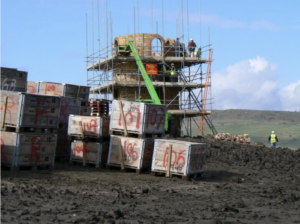
When Clavell Tower became at risk of falling into the sea due to erosion in the 1980s, the current owner of Smedmore House – historian Dr Philip Mansel (related by marriage to the Clavell family) – launched a campaign to save it.
The tower was painstakingly taken apart, stone by stone, and relocated further inland, before being renovated for use as a holiday let.
You can still see the original position of the tower in the ground, close to the cliff edge.
Staying at Clavell Tower
For a stylish, yet wild retreat with a sense of history, book a stay at Clavell Tower. With a 360° view from the living area, a weekend away at this windswept wonder will leave a lasting memory.
Note that, due to its unusual location and character, it tends to be booked up months in advance, so you may have to wait for your chance to stay here.
Accommodation
The four-storey tower sleeps up to two people and is equipped with much of the mod-cons you’d expect from traditional self-catering, including a fully-equipped kitchen, a bathroom with a shower, various heating options and a welcome pack including tea, coffee and milk.
Fresh towels, bed linen (bed is made up) and toilet roll are provided, however some items and facilities you may be used to such as a hair dryer and WiFi are not available.
Safety information
The nearby cliffs are unfenced and visitors should keep a sensible distance from them at all times.
Access to the tower is solely on foot up a steep hill with steps and in an exposed, remote location. As such, the Landmark Trust recommends a stay at Clavell Tower for ‘hardier’ visitors only, and is not suitable for people with heart or respiratory health conditions.
Rucksacks are recommended for transporting personal belongings from your car, and visitors are advised to bring sturdy walking boots and torches.
For availability and booking visit the Landmark Trust’s website: www.landmarktrust.org.uk/search-and-book/properties/clavell-tower
🐾 Dog-friendly
How to get there
For your SatNav: BH20 5PF (this will take you to the toll road (£5) for Kimmeridge Bay.
If you keep going down the track to the left once you see the main car park for the bay there is a second, smaller car park, which is closer to the tower.
From here, you will need to go on foot up the hill to reach Clavell Tower.
Safety information
Children should be closely supervised and dogs kept under control and on a short lead due to the unfenced, sheer cliff.
The path and steps up to Clavell Tower can be slippery after wet weather.

Nearby follies and architectural curiosities
If Clavell Tower has inspired you to seek out other follies and interesting historical structures, there are plenty to be found within Purbeck itself:
- Grange Arch – This 18th Century folly is a hidden gem amongst the Purbeck Hills. Built by the owner of Creech Grange in 1746 as an ‘eyecatcher’, it is now Grade II-listed and National Trust-owned. Find it by parking at the viewpoint off Grange Hill, close to Tyneham and above the hamlets of Creech and Steeple
- Durlston Castle – The folly castle in Durlston Country Park was built between 1886 and 1887 by Swanage’s founding fathers John Mowlem and George Burt as part of their newly-developed Durlston Estate. It was used as a restaurant for visitors, and it still is today, as well as being home to the Park’s visitor centre, shop and function rooms
- The Great Globe – The three-metre-wide, 40-tonne sphere at Durlston is another of Burt and Mowlem’s unique legacies. It depicts the world’s continents and is carved with interesting inscriptions
- The Obelisk – Yet another of Burt’s offerings to Swanage is the Obelisk that looks down over Swanage Bay from a hill to the north of the town. It was erected in 1892 to celebrate the town’s new water supply
- Wellington Clock Tower – Located at the southern end of Swanage near to Peveril Point, the Wellington Clock Tower was brought by George Burt from London for three purposes – as a ballast for his ship during transportation, as a ‘house-warming’ gift to a friend, and as part of his ongoing efforts to gentrify the town. The quirky landmark is unusual not only in its incongruity with the area, but in its incompleteness – it is missing the actual clock and the intended statue of the Duke of Wellington was never installed
- Fort on the lake, Lulworth – This circular folly was created by the Weld family, the owners of the Lulworth Estate in the 1800s as a feature of its lake, which was used for testing model boats for the Admiralty. It also used used to have canons but they have since been removed
- Celtic cross, Studland – In Studland village is a large Celtic cross, which seems initially incongruous with its surroundings until you examine it and see that it is heavily carved with images depicting the area’s history. This newer version (1976) stands of the site of a previous Saxon cross
For follies further afield in Dorset, try exploring these:
- Kingston Lacy’s Philae obelisk – A day exploring the extensive grounds and mansion house of the National Trust-owned Kingston Lacy near Wimborne is packed with history and intrigue. One of the more curious artefacts is the ‘Philae’ obelisk, set within Kingston Lacy’s parkland. The nine-metre tall pink granite piece was brought here from Egypt by William John Bankes in 1821 and dates back to 150BC and is inscribed with hieroglyphics. It is now Grade II-listed. Find out more and visit Kingston Lacy, where the original keys to Corfe Castle are also kept (Kingston Lacy was part of the Bankes’ estate gifted to the National Trust): ℹ️ www.nationaltrust.org.uk/kingston-lacy/features/the-philae-obelisk 📞 01202 883402
- Athelhampton – The dovecote at the Athelhampton House is just one of the many interesting features of its architectural gardens. Plan your visit to the Tudor mansion near Dorchester via their website: www.athelhampton.com 📞 01305 848363
- Sherborne Castle mock ruin – The mock-ruined tower at Sherborne was built in the 18th Century for the then owner Lord Digby to make his garden more beautiful. Sherborne Castle and Gardens is in North Dorset. Find out more on their website: www.sherbornecastle.com 📞 01935 813182
- Charborough Tower – The fascinating, Grade II-listed Charborough Tower, north of Wareham and near to Sturminster Marshall, was originally built in 1879 by the Drax family, which owns the estate (South Dorset MP Richard Drax currently resides at Charborough House). However, after being struck by lightning, the tower was repaired and improved in 1839. Octagonal in structure, the folly now has five storeys and, it’s said, you can see four counties from the top of the tower. It is on privately-owned land, however Charborough’s gardens are occasionally open to the public for charity events. The folly features in the Thomas Hardy Novel Two on a Tower. More information can be found on the Charborough Estate’s website: www.charborough.co.uk
- Horton Tower – The 43-metre-high red brick, Gothic Horton Tower near Wimborne is Grade II-listed and has found a new lease of life in our modern world as a mobile phone mast. Originally used as an observatory, the folly had seven floors, but much of the internal structure has since degraded


